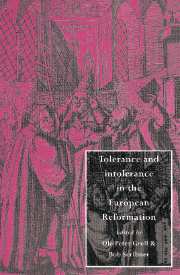Book contents
- Frontmatter
- Contents
- List of contributors
- Preface
- Dedication
- 1 Introduction
- 2 The travail of tolerance: containing chaos in early modern Europe
- 3 Preconditions of tolerance and intolerance in sixteenth-century Germany
- 4 Heresy executions in Reformation Europe, 1520–1565
- 5 Un roi, une loi, deux fois: parameters for the history of Catholic-Reformed co-existence in France, 1555–1685
- 6 Confession, conscience and honour: the limits of magisterial tolerance in sixteenth-century Strassburg
- 7 One Reformation or many? Protestant identities in the later Reformation in Germany
- 8 Toleration in the early Swiss Reformation: the art and politics of Niklaus Manuel of Berne
- 9 Tolerance and intolerance in sixteenth-century Basle
- 10 Exile and tolerance
- 11 The politics of toleration in the Free Netherlands, 1572–1620
- 12 Archbishop Cranmer: concord and tolerance in a changing Church
- 13 Toleration for Catholics in the Puritan revolution
- 14 The question of tolerance in Bohemia and Moravia in the age of the Reformation
- 15 Tolerance and intolerance in sixteenth-century Hungary
- 16 Protestant confessionalisation in the towns of Royal Prussia and the practice of religious toleration in Poland-Lithuania
- Index
12 - Archbishop Cranmer: concord and tolerance in a changing Church
Published online by Cambridge University Press: 07 December 2009
- Frontmatter
- Contents
- List of contributors
- Preface
- Dedication
- 1 Introduction
- 2 The travail of tolerance: containing chaos in early modern Europe
- 3 Preconditions of tolerance and intolerance in sixteenth-century Germany
- 4 Heresy executions in Reformation Europe, 1520–1565
- 5 Un roi, une loi, deux fois: parameters for the history of Catholic-Reformed co-existence in France, 1555–1685
- 6 Confession, conscience and honour: the limits of magisterial tolerance in sixteenth-century Strassburg
- 7 One Reformation or many? Protestant identities in the later Reformation in Germany
- 8 Toleration in the early Swiss Reformation: the art and politics of Niklaus Manuel of Berne
- 9 Tolerance and intolerance in sixteenth-century Basle
- 10 Exile and tolerance
- 11 The politics of toleration in the Free Netherlands, 1572–1620
- 12 Archbishop Cranmer: concord and tolerance in a changing Church
- 13 Toleration for Catholics in the Puritan revolution
- 14 The question of tolerance in Bohemia and Moravia in the age of the Reformation
- 15 Tolerance and intolerance in sixteenth-century Hungary
- 16 Protestant confessionalisation in the towns of Royal Prussia and the practice of religious toleration in Poland-Lithuania
- Index
Summary
Let us begin by defining terms. Particularly helpful are recent discussions of toleration by Mario Turchetti and Malcolm Smith, which although directed towards the religious divisions of sixteenth-century France, have a wider application. From Turchetti, we can draw the distinction between concord and tolerance: that is, refusal of diversity versus acceptance of diversity. With the help of friendly criticism of Turchetti's position made by Smith, we can refine this distinction still further. There are two sorts of concord or refusal of diversity: one can enforce concord and overcome diversity by coercion, prohibition and ultimately violence, or one can seek concord by discussion and persuasion, the spinning of formulae and the cultivation of generous vagueness in definition. Naturally, it is possible to slide from one to the other: a famous example, one indeed much quoted in the Reformation, would be Augustine of Hippo's change of stance on the Donatists to ‘compel them to come in’, once conferences had failed. More happily, on occasion, coercion can move to discussion in the search for true concord.
Moving on from concord to tolerance: as Turchetti points out, tolerance implies the recognition of something which is forbidden and which remains forbidden. It involves concessions by an authority which remains in a superior position, in a society which has not fundamentally adjusted its structures or the ideologies which legitimises them, even though it is putting up for the time being with an alternative set of ideas.
- Type
- Chapter
- Information
- Tolerance and Intolerance in the European Reformation , pp. 199 - 215Publisher: Cambridge University PressPrint publication year: 1996
- 1
- Cited by



